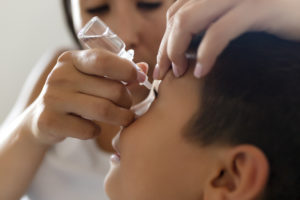December 1, 2020
By Dwight Akerman, OD, MBA, FAAO, FBCLA
 In this randomized, placebo-controlled, double-masked study, researchers tested the safety and effectiveness of 0.01 percent low-dose atropine eye drops on slowing myopia progression and axial elongation in Chinese children. In total, 220 children, aged 6 to 12 years, with myopia of −1.00D to −6.00D in both eyes, were recruited between April 2018 and July 2018 at Beijing Tongren Hospital, Beijing, China. Study participants were randomly assigned in a 1:1 ratio to atropine, 0.01 percent, or placebo groups to be administered once nightly to both eyes for one year.
In this randomized, placebo-controlled, double-masked study, researchers tested the safety and effectiveness of 0.01 percent low-dose atropine eye drops on slowing myopia progression and axial elongation in Chinese children. In total, 220 children, aged 6 to 12 years, with myopia of −1.00D to −6.00D in both eyes, were recruited between April 2018 and July 2018 at Beijing Tongren Hospital, Beijing, China. Study participants were randomly assigned in a 1:1 ratio to atropine, 0.01 percent, or placebo groups to be administered once nightly to both eyes for one year.
The researchers found that a once-nightly dose of 0.01 percent atropine eye drops resulted in a reduction of myopia progression by a mean (SD) of 0.26 (0.07) D (34.2% reduction) and axial elongation by 0.09 (0.03) mm (22.0 percent reduction) compared with placebo treatment. Though the mean progression of axial length was lower in the 0.01 percent atropine treatment group than the control group, the reduction of axial elongation by 0.09 mm at one year is not of great clinical significance. Also, 51 percent and 13.2 percent of children progressed by at least 0.50D and 1.00D in the 0.01 percent atropine treatment group, compared with 69.9 percent and 34.9 percent in the placebo group.
Previous studies have demonstrated a dose-dependent effect of atropine on reducing myopia progression. It would be a reasonable strategy for myopic children to be treated initially with 0.01 percent atropine. If myopia progression continues greater than -0.50D (0.25 mm axial length) per year, then change to a higher concentration, e.g., 0.025 percent or 0.05 percent.
It is believed that this study is the first randomized, double-masked, placebo-controlled trial to show the efficacy of 0.01 percent atropine eyedrops in mainland China. However, the clinical relevance of these results cannot be determined from this trial because there was a loss to follow-up of approximately 30 percent, the follow-up is limited to one year, and it is not known whether these findings translate to a slowing of myopia-associated pathologies.
Abstract:
Safety and Efficacy of Low-Dose Atropine Eyedrops for the Treatment of Myopia Progression in Chinese Children
Shifei Wei, MD, PHD; Shi-Ming Li, MD, PhD; Wenzai An, MD; Jialing Du, MD; Xintong Liang, MD; Yunyun Sun, MD, PhD; Duoxing Zhang, MD; Jiaxin Tian, MD; Ningli Wang, MD, PhD
Importance: Because studies have suggested that atropine might slow the progression of myopia in children, randomized clinical trials are warranted to understand this potential causal relationship.
Objective: To evaluate the efficacy and safety of atropine, 0.01 percent, eyedrops on slowing myopia progression and axial elongation in Chinese children.
Design, Setting and Participants: This was a randomized, placebo-controlled, double-masked study. A total of 220 children aged 6 to 12 years with myopia of −1.00D to −6.00D in both eyes were enrolled between April 2018 and July 2018 at Beijing Tongren Hospital, Beijing, China. Cycloplegic refraction and axial length were measured at baseline, 6 months and 12 months. Adverse events were also recorded.
Interventions: Patients were randomly assigned in a 1:1 ratio to atropine, 0.01 percent or placebo groups to be administered once nightly to both eyes for one year.
Main Outcomes and Measures: Mean changes and percentage differences in myopia progression and axial elongation between atropine, 0.01%, or placebo groups.
Results: Of 220 participants, 103 were girls (46.8 percent), and the mean (SD) age was 9.64 (1.68) years. The mean (SD) baseline refractive error and axial length were –2.58 (1.39) D and 24.59 (0.87) mm. Follow-up at one year included 76 children (69 percent) and 83 children (75 percent) allocated into the atropine, 0.01 percent, and placebo groups, respectively, when mean myopia progression was −0.49 (0.42) D and −0.76 (0.50) D in the atropine, 0.01 percent, and placebo groups (mean difference, 0.26 D; 95 percent CI, 0.12-0.41 D; P < .001), with a relative reduction of 34.2 percent in myopia progression. The mean (SD) axial elongation in the atropine, 0.01 percent, group was 0.32 (0.19) mm compared with 0.41 (0.19) mm in the placebo group (mean difference, 0.09 mm; 95 percent CI, 0.03-0.15 mm; P = .004), with relative reduction of 22.0 percent in axial elongation. Fifty-one percent and 13.2 percent of children progressed by at least 0.50D and 1.00D in the atropine, 0.01 percent, group, compared with 69.9 percent, and 34.9 percent in the placebo group. No serious adverse events related to atropine were reported.
Conclusions and Relevance: While the clinical relevance of the results cannot be determined from this trial, these one-year results, limited by approximately 70 percent follow-up, suggest that atropine, 0.01 percent, eyedrops can slow myopia progression and axial elongation in children and warrant future studies to determine longer-term results and potential effects on slowing sight-threatening pathologic changes later in life.
Wei, S., Li, S. M., An, W., Du, J., Liang, X., Sun, Y., … & Wang, N. (2020). Safety and Efficacy of Low-Dose Atropine Eyedrops for the Treatment of Myopia Progression in Chinese Children: A Randomized Clinical Trial. JAMA ophthalmology.
doi:10.1001/jamaophthalmol.2020.3820













